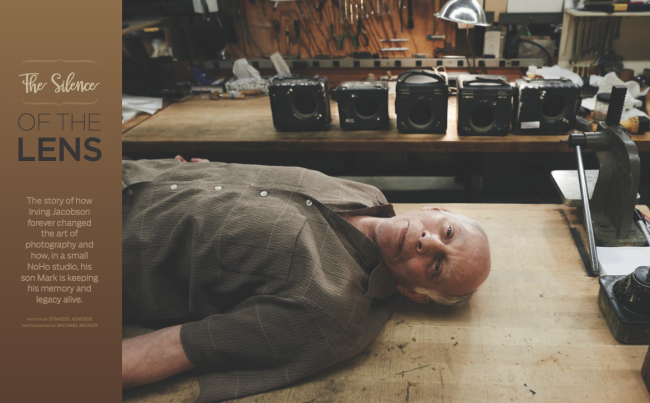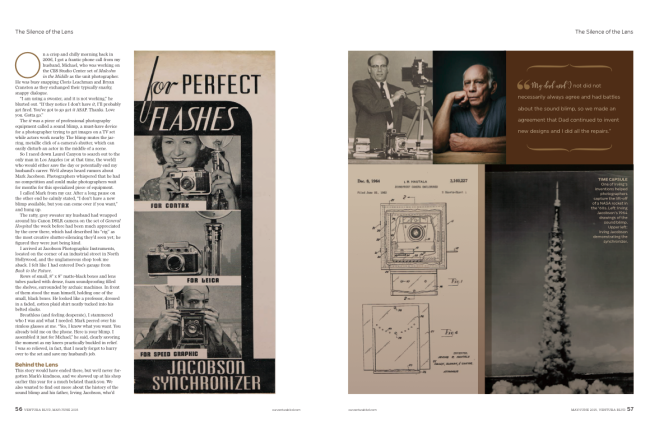Ventura Blvd Magazine
Editor-in-Chief: Linda Grasso
Creative Director: Ajay Peckham
Graphic Designer: Elena Lacey, Michelle Villas
Photographer: Michael Becker
Heidi: Tell us about your commercial photography as a second career. What caused you to make the switch?
Michael: I was drawn to both music and photography from an early age. When I was 11 my grandfather, who was a professional photographer in Manhattan, gave me his beautiful old 1950’s Rolleiflex. I was immediately hooked. When I hit my teens, I became increasingly interested in music, particularly blues and jazz. I started playing guitar and ended up going to the Berklee College of Music in Boston. After graduating I moved to Los Angeles and spent the next 15 years in the studio making music.
Several things happened that ultimately led me back to photography. In the year 2000 there was a commercial actors strike that had a dramatic effect on some of my clients and my business as a composer/producer. Shortly after that, both my parents became very ill. I decided to move back to New York to help take care of them and to deal with the difficult transitions. It was then that I rediscovered my grandfather’s old Rolleiflex. Taking photos of my parents and the town where I grew up became both an escape and a way of documenting what my family was going through. There was something about the immediacy of photography that resonated with me. I was hooked all over again.
I know your first career was as a successful music composer, how do the two interplay, if at all?
They both have the incredible power to move people, and to reflect and comment on social conditions. After years of making music, I found photography refreshing in that I could make a photograph relatively quickly, whereas writing and producing a song can be a rather lengthy process.
My professional experience has been that both require a strong, individual voice or vision, but they are also fertile playgrounds for collaboration. I loved playing in bands and working in the studio with other musicians. Photography is also a great collaboration, starting with the entire creative team, through to the subject interaction with the photographer.
My biggest lesson from music carried forward into photography is to trust the creative process. Don’t set out to make something perfect, set out to make something authentic and then subject it to a heathy dose of scrutiny and refinement.
How did you execute the Mark Jacobson story? I understand you turned over a completely researched idea both editorially and photographically. How long did this process take?
I have been working with a wonderful editor and photography consultant, Lisa Thackaberry. I was interested in doing more editorial work in addition to my entertainment work. My wife, Staness Jonekos, had also done a major career switch from television executive producer to published author. It was Lisa that suggested we find an interesting story to tell and work as a team doing the story and photography. She suggested we pitch magazines directly and thought going in with a complete article might be a viable way to get published. Since staffing and budgets are down in editorial, it made sense to try and create our own opportunity.
My wife immediately remembered our first encounter with Mark when I started working in entertainment and thought it might be an interesting story. I loved the idea and reached out to him to see if he would be open to doing it. After explaining our intentions, he agreed and we set up the first interview. It wasn’t until we sat down with him that we realized what a rich history there was with him and his father Irving. Irving had quite a remarkable career prior to inventing the first camera sound blimp. From the time I first called Mark to when the article was published this month, took almost a year.
What compelled you to share this story and why this magazine?
To our surprise, there had been almost nothing written about the sound blimp. Just Mark’s web site and a couple of mentions in users’ blogs. Such an obscure thing, surely there must be an interesting story. It’s been a part of film and television publicity and marketing for decades. Many film marketing one-sheets are made from the unit stills shot by the onset photographer. Shots that could never have been captured with a noisy camera snapping away during an actual take.
Once again it was Lisa Thackaberry that suggested we pitch it to Ventura Blvd Magazine (VB). She thought the local business angle was a great fit since his shop is in Studio City. VB does fantastic stories on local businesses and they still dedicate a luxurious amount of space to photographs.
Were you surprised that this story hadn’t been told as it’s such an important part of photo history?
We were definitely surprised at how little information was out there. In general, on set photographers are there for the publicity and marketing teams, not as part of the actual production. The very nature of the job requires a certain amount of stealth, thus I think it gets somewhat overlooked.
What compelled you to ask about the family history?
We were aware that it was Mark’s father who originally invented the first blimp. We were just curious what prompted him to design such a seemingly proprietary piece of gear. What kind of demand could there possibly have been at the time other than a few one-offs. Now blimps are used everywhere, from television and film sets to theater productions, golf tournaments, etc. Any place the clicking of a camera is a distraction to the action.
Was Mark surprised that the story made the cover? ( ie…not a publishers idea of a sexy subject )
He was completely blown away that he made the cover. We all were! Linda Grasso, Editor-in-Chief, and the amazing design team at VB literally picked our favorite photograph from the whole shoot to use on the cover. We couldn’t have been happier with the layout.
I think there’s great value in local publications and being connected to community, is that why you pitched this to Ventura Blvd?
Yes, it just seemed like a great fit given the proximity and the fact that VB is still prominently featuring photography. Plus we live in the hills above Studio City so it felt like it was relevant to us as both members of the community, and also the industry.
I know you shot Nancy Cartwright for the magazine, did you ask her to do her Bart Simson for you?
I did not, but I know she’s all too happy to oblige when someone asks.
What were you trying to capture when you photographed her and was it hard to separate her from that iconic voice?
Nancy is an incredibly talented voice over artist and an explosive bundle of energy. I simply tried to capture the exuberance she has for her new passion with sculpting. Clearly Bart is an inseparable part of her that she embraces and is protective of. I completely enjoyed the time the three of us spent together!




1 Comment
When selecting photographers for the art of the personal project, what is your selection criteria? I have an ongoing personal project documenting African American life in my beloved Harlem community. I started the project in 2008. A small portion can be seen on my multipurpose website. Given the terrifying nature of gentrification–forced displacement–my project is all about trying to capture what is soon to be lost forever in Harlem regarding black social activities, businesses, organizations and its people. I believe this project is significant because, Harlem once was the capital of African American culture in the United States its gradual disappearance is a tragedy making a compelling entry for your audience.
Comments are closed for this article!